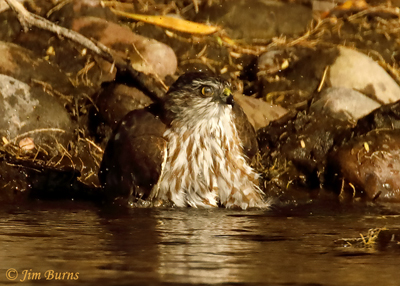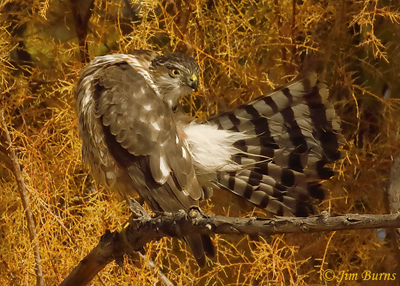
Upstream I watch Great Blue Heron negotiations over a foraging territory. From somewhere downstream comes the rattle of a Belted Kingfisher. This is the season when wildlife reclaims its riparian domain, and my target this picture postcard desert morning is Bobcat, though I’d gladly settle for Coyote or one of the resident Bald Eagles. I watch Song Sparrows pluck larval caddisfly casings from the shallows, and a flock of Western Bluebirds has found the berries on a Mistletoe bunch. Every winter day is different here, none without surprise, none bereft of natural wonder and beauty.
My eye catches movement across the river in a twisted tangle of mesquite roots overhanging the water where a previous flood has created a cutbank. A small movement. The opposite side is perhaps thirty yards away, but the rising sun is directly behind me so the tangle is well lit. I raise the binoculars and watch, expecting something to pop out into full view, sparrows, an overwintering warbler, or perhaps a Bewick’s Wren, birds too small to photograph well at this distance, but nothing moves.
My eyes follow along the shoreline. There is a Black Phoebe flycatching on rocks fifty yards upstream, out of range for my lens. My eyes wander back to the tangle. Still I see nothing. I glance at my watch, daydreaming about the time I chanced upon a juvenile Peregrine bathing in the river at almost this exact spot. Apparently the water level here and the size of the river rocks make pools just right for a raptor but unsuitably deep for the smaller birds that love to bathe in puddles and rainpools.
I am in plain sight of anything that may come to the water’s edge to drink or bathe across from me but, eschewing a blind to have more freedom of movement, I am sitting on a large rock at the very edge of the river’s flow, hunkered down behind the camera, the tripod breaking up my outline. It has been fully half an hour since I first espied something in the tangle. Just as I begin to consider going upriver to another spot, I see movement again. Big movement this time. Disbelieving because so much time has passed, I look through the camera. A hawk has dropped out of the mesquite and is sitting in the water! It is an accipiter. It is staring right at me.
No less an experienced and accomplished birder/photographer than our local Cindy Marple has stated publicly that “Coop and Sharpie is a pairing I struggle with.” Me too Cindy, but this is one large accipiter. As I pray the bird will actually bathe without being spooked by any small movement I make behind the camera, I decide I’ll wait to label it until I see more diagnostic features.
It proves a long wait. The bird is a juvenile, judging by its light iris and the beautiful vertical rufous streaking on the underparts, and it sits in the river motionless, occasionally looking my way, for half an hour. “Bathe, dammit,” I think to myself as my legs begin cramping up and then, as if on cue, my prayer is answered. It proceeds to give me the full show, nearly ten minutes worth, as it dunks, splashes, flaps, and wallows, nictitating membrane often drawn shut, water spraying everywhere. I have been privileged to watch accipiters bathe several times, but this is the most thorough and prolonged I’ve ever witnessed.
Finally the hawk rises from the river, water dripping in a steady stream, and perches on a tamarisk branch, still bankside and within range of my lens, and I witness something I’ve never seen before. It fully spreads the dorsal surface of its wings and tail to the sun, just as we’ve all seen Turkey Vultures and cormorants do, to dry out its feathers. A perusal of the literature confirms that raptors do this, but it is a first for me.
After sunning for ten minutes, adjusting its position periodically for optimal sun angle, the hawk begins to preen. Wings, tail, breast, flanks, no feather left ignored. The view which finally convinces me to call this a Coop comes when the underside of the tail is fanned as it plucks at the fluffy white undertail coverts and I see that the terminal band of light feathers is as wide as the dark band above it. Since I’m struck with the thought it is one of the largest accipiters I’ve ever seen, I’ve labeled it “Copper’s Hawk female, juvenile.”
My watch says the elapsed time, from when I first saw movement as the hawk slipped surreptitiously down to the river until it flew from its preening post, has been three hours. I can only attribute this individual’s extreme initial caution at getting in the water and its lengthy, meticulous grooming routine to its young age. And I smile to myself thinking only a teenage girl could possibly spend this much time on her toilette.
I can’t help but marvel, as I leave, at how different this scene must have looked six months ago at high water during the height of summer, overrun by the heathen hordes who congregate here devoid of the knowledge and appreciation for what this desert river meant to the original human inhabitants and the creatures with whom they respectfully shared it. Winter is surely the season to revel in its solitude and beauty.